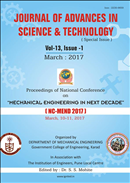Experimental Investigation of Convective Heat Transfer by Permeable Fins at Different Angles of Inclination and Reynolds Numbers in Forced Convection
Impact of Permeable Fins on Convective Heat Transfer
Keywords:
convective heat transfer, permeable fins, angles of inclination, Reynolds numbers, forced convectionAbstract
Heat dissipation management is significant job in industries, where temperature conditions play vital role. For proper heat dissipation fins are extensively used. In this study heat transfer coefficients of solid fins and permeable (porous) fins are compared for same heat input and surrounding temperature under forced convection conditions. Also affect of Reynolds no (Re) and angle of inclination (θ) is analysed. Permeable fins are made by drilling holes on plane surface of solid fins. Experimentation has been carried out for 3 holes, 5 holes 6 holes and 8 holes. It has been found that heat transfer coefficient increases with increase in no. of holes. But increase in angle of inclination decreases heat transfer coefficient i.e. maximum heat transfer coefficient is observed when angle is 0°with constant surface area in forced convection. And as Re increases heat transfer coefficient also increases. For 8 holes fin with flow of Re = 20000 and 20 W of heat input, 37.9 % increase in heat transfer coefficient is achieved over solid fins.Downloads
Download data is not yet available.
Published
2017-03-10
Issue
Section
Articles






